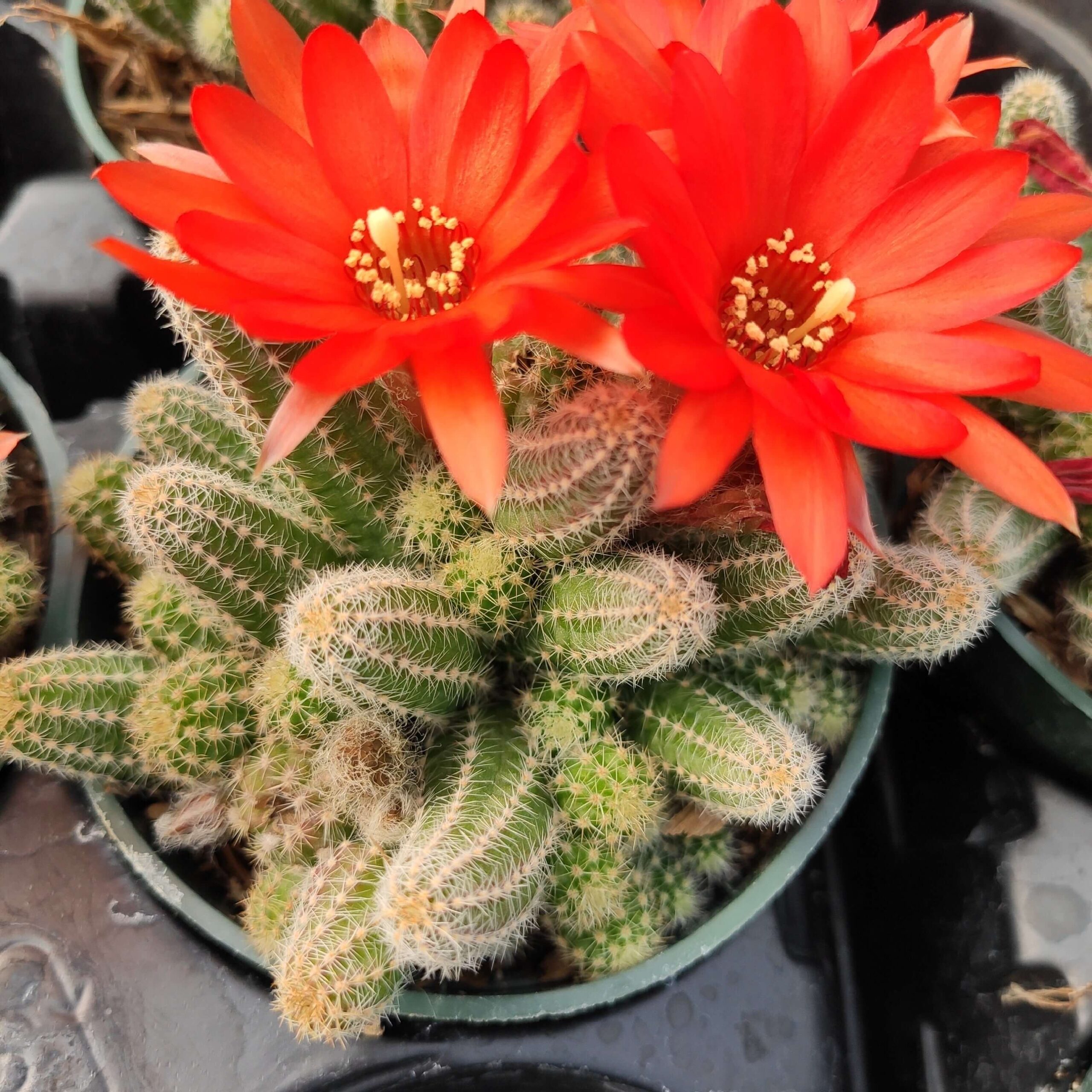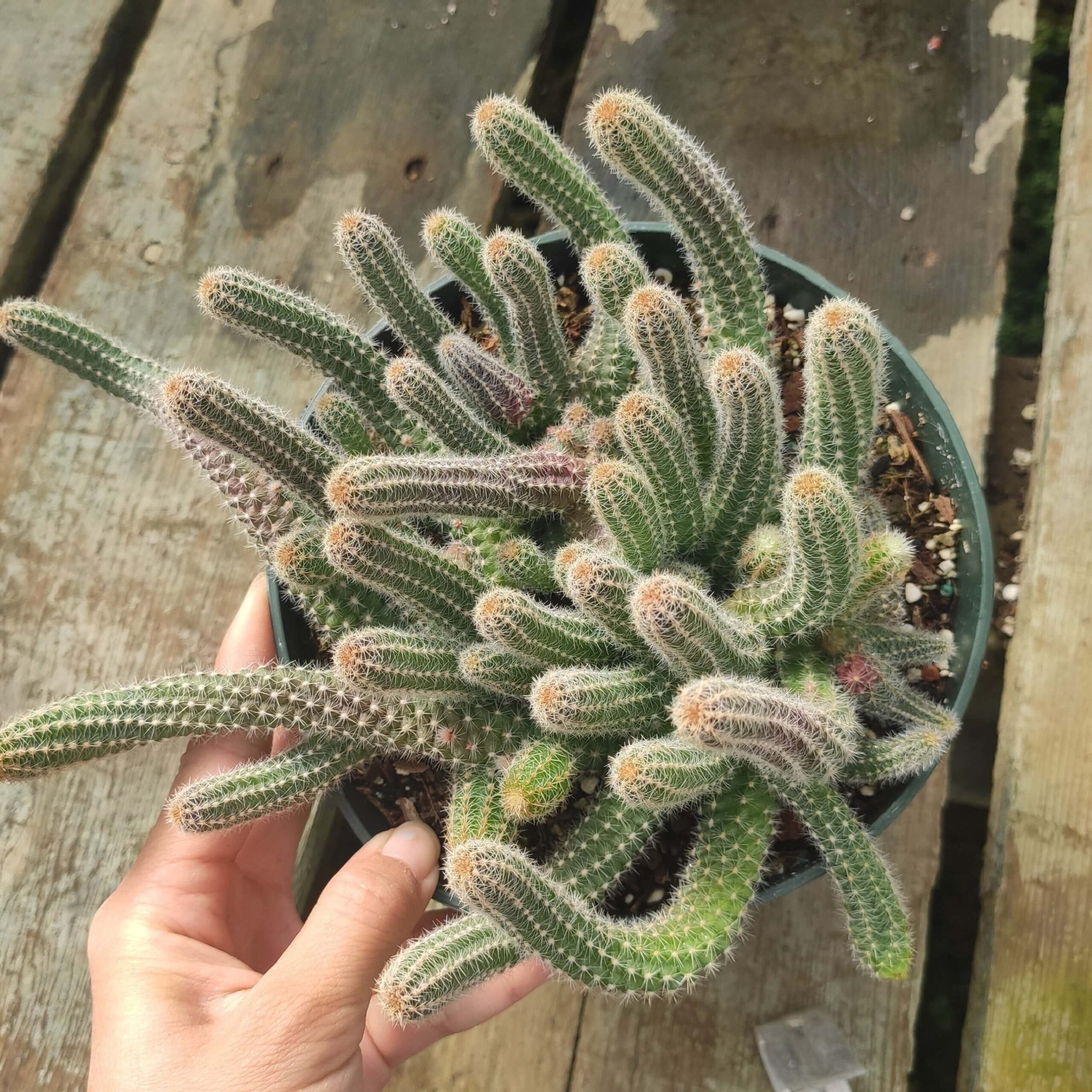The peanut cactus, also known as the peanut cactus or Echinopsis chamaecereus, is a small, globular cactus that grows in clustered stems resembling peanuts. With its cute appearance, compact size, and flowering potential, this easy-care succulent makes for a delightful houseplant.
With proper growing conditions, the peanut cactus remains small, topping out around 3-6 inches in height. Its clustered, bulbous stems give rise to its nickname, resembling peanuts scattered together.
The light green stems have distinct ridges lined with tiny spines. In summer, they may produce delicate pink or white flowers with a lovely fragrance.
| Botanical Name | Echinopsis chamaecereus |
| Plant Family | Cactaceae (Cactus Family) |
| Common Name | Peanut Cactus |
| Plant Type | Succulent |
| Mature Size | 3-6 inches tall x 6-12 inches wide |
| Growth Habit | Clustered globular stems |
| Foliage | Spiny, cylindrical green stems |
| Sunlight | Bright indirect to partial sun |
| Soil | Gritty, fast-draining |
| USDA Zones | 10-12 (mostly grown as houseplants) |
| Exposure | South or West |
An identifying feature of the peanut cactus is the woolly areoles on the stems from which spines emerge. The spines are quite small and harmless. Mature clusters can grow up to 6 inches tall and over a foot wide.
Peanut Cactus Varieties
While Echinopsis chamaecereus is the most popular variety, a few others exist:
- Echinopsis chamaecereus ‘Nana’ – A dwarf cultivar that only reaches 2 inches tall, with vivid green stems.
- Echinopsis chamaecereus ‘Chamaeleon’ – Features longer, thinner stems in shades of purple, red, and green. Grows up to 5 inches.
- Echinopsis backebergii – Very similar to E. chamaecereus but with fuzzy areoles. Slightly faster growing.


Flowers and Fragrance
One of the best parts of growing a peanut cactus is when it produces flowers in the summer. The blooms emerge from the woolly areoles, lasting up to a week when open. They add a pop of color and have a lovely fragrance.
Its Flowers range from white to shades of pink, sometimes with yellow centers. Some varieties like Echinopsis chamaecereus ‘Rubra’ have rich fuchsia blooms. These petite flowers can open up to 2 inches wide when fully expanded during the day.
Make sure to situate your peanut cactus somewhere you can enjoy the charming blossoms and sweet scent up close!
Peanut Cactus Care
Caring for peanut cactus is fairly simple since they are accustomed to dry desert-like conditions. Here are the key aspects of peanut cactus care to keep in mind:
Light
Peanut cactus thrives in bright, indirect light, tolerating some direct morning or evening sun exposure. Situate it near a south or west-facing window where it will receive plenty of sunlight. A minimum of 4 hours a day is recommended.
Signs of insufficient light include weak, stretched-out growth and a lackluster appearance. Flowering may also be reduced. If your plant exhibits these traits, move it to a brighter location.
Temperature and Humidity
As a desert succulent, peanut cactus prefers warm and dry conditions. Ideal temperatures range between 60-80°F. Cooler temperatures around 50°F can be tolerated in winter when growth slows. Avoid exposing the cactus to frost or freezing conditions.
Average indoor humidity is perfectly fine. Just provide them with decent airflow and circulation so moisture doesn’t accumulate on the fleshy stems.
Soil
Use a fast-draining cactus or succulent soil blend. You can make your own by mixing equal parts potting soil, perlite or pumice, and horticultural sand or small gravel. This gritty, sandy soil mixture mimics the quick-draining desert terrain that peanut cactus has adapted to.
Make sure the pot has drainage holes to prevent moisture from pooling at the roots. Avoid standard potting mixes that retain too much water.
Water
When it comes to watering, less is more with cacti plants. Peanut cactus should only be watered once the potting mix has fully dried out, which may mean watering every 2-3 weeks. The top few inches of soil should be dry to the touch before adding more water.
Water thoroughly until it drains freely from the holes at the bottom, ensuring it penetrates deep into the roots. Then let excess water escape before returning the pot to its home. This soak-and-dry approach helps leach salts that can accumulate in soil.
Take care not to overwater, as soggy soil can cause root rot and other harmful fungus or bacteria. Underwatering is preferable to overwatering when in doubt!
Fertilizer
Fertilizing is not strictly necessary but can be beneficial if done properly. Use a balanced houseplant or cactus fertilizer at half-strength during spring and summer when plants are actively growing. Dilute to avoid fertilizer burn.
I’ve had great results using an organic fish emulsion or compost tea a few times over the growing season. Just make sure to flush the soil with clean water every few months to prevent salt accumulation.

Propagating Peanut Cactus
One of the easiest ways to multiply your peanut cactus collection is through offsets – the small, baby plants that form around the base of the mother plant. Offsets have their own set of roots but are still connected to the main plant.
Carefully twist and pull offsets away using sterilized tools, keeping some roots attached to each one. Allow offsets to dry for 2-3 days before repotting in small pots with well-draining cactus soil.
Place in bright, indirect light while they establish roots and show new growth. Then you can move them into more light. Propagated plants also bloom faster than seed-grown ones.
You can also propagate a peanut cactus from cuttings. Use a clean, sharp knife or shears to cut a 4-5 inch segment off a stem. Allow the cutting to callous for a few days before planting in soil. Water sparingly until it develops roots and resumes growth.
Potting and Repotting Peanut Cactus
To keep your peanut cactus happy and flowering, repot it every 2-3 years in the spring. Choose a container only 1-2 inches wider than the current pot, as these plants are slightly rootbound. Make sure the pot has drainage holes at the bottom.
Use a well-aerated cactus soil blend, adding in 20% perlite or pumice. To encourage faster drainage, you can add pebbles or small stones at the base of the pot. Position the peanut cactus at the same level it was growing previously, firming the soil gently around the roots.
After repotting any plant, wait 7-10 days before watering again to avoid root rot. Your peanut cactus may show signs of transplant stress like drooping for a short time. Place it in bright, indirect light while it recovers.
For mature plants that won’t be repotted frequently, using a clay or terracotta container allows air to pass through pores in the pot walls. Or, plant in a plastic nursery pot with drainage holes, placing that container inside a slightly larger decorative one without holes at the base. This creates a reservoir for excess water to prevent root rot.
Common Problems With Peanut Cactus
When provided with suitable growing conditions, the peanut cactus proves to be quite resilient and low-maintenance. But there are still a few potential problems to watch for:
- Leggy growth – Insufficient sunlight causes weak, stretched-out growth as the cactus reaches for light.
- Failure to bloom – Inadequate light, improper soil moisture, and lack of a winter dormancy period can prevent flowering.
- Mealybugs & spider mites – Common houseplant pests that leave small white deposits or webbing on the plant. Wipe leaves with alcohol or insecticidal soap.
- Overwatering – Yellow leaves, soft/mushy stems, foul odor, and eventual collapse. Allow the soil to dry out completely before watering again.
- Underwatering – Wrinkling, deflated stems. Water thoroughly when the soil is completely dry.
- Root Rot – Caused by overly moist soil. Prune affected roots and repot in fresh, dry soil.
FAQs
Maximize flowering by providing excellent care when growth is most active – plenty of sun, perfect watering, and warm spring/summer temperatures. Mature, healthy plants that aren’t rootbound bloom most prolifically.
As a relatively common succulent, peanut cactus houseplants typically cost between $5-15 depending on age and size. Rare varieties can be pricier.
No, peanut cactus should not be eaten. The small, peanut-like cacti contain alkaloids and other compounds that can cause illness if ingested. Appreciate this one just for its ornamental merits!
Look for the clustered, cylindrical stems covered in woolly areoles and fine spines reminiscent of peanuts or hedgehogs. The offshoots will be connected at the base with a segmented main stem and shallow root system.
